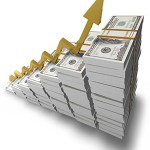Whistling In The Graveyard?
The time has come to revisit the point and figure chart that I began several weeks ago. As of today, we can officially make some adjustments to the chart, as 1.30 was reached in intra-day trading. The result is a new column of O’s that can now be added to the chart, because a 3 point reversal has occurred.
8……………………………………..1.65…( 8= August, 2008)
O……………………………………..1.60
O……………………………………..1.55
O…X…………………………………1.50 (Reaching 1.50 would be a double top breakout)
O…X…O…X………X………………1.45 This is a double top at 1.45, indicating resistance to 1.50
O…X…O…X…O….X…O………….1.40
O…X…O…X…O….X…O………….1.35
O……..O………O……..9………….1.26<—Quadruple bottom, indicating support (4 O’s) (9 = September)
……………………………………….1.25 (Reversing to 1.25 would be a Quadruple bottom breakout)
As I expected, the stock continues to trade within the given range. The next potential chart moves would be at 1.25 below the “9,” which would be a very bad thing, signaling lower potential downside risk, or a reversal back to 1.45 and a new column of X’s.
More importantly, what occurred in August is known as an accumulation phase. The chart makes it very clear where supply (1.45- 1.49), and demand (1.26-1.30) lie in the equity. Trading sideways is not a bad thing, especially when it follows a long term downtrend as we have seen with this stock. This could very well be a signal of a reversal in the downtrend, that could occur before our eyes.
At this point, I would suggest placing stops between 1.20 and 1.24. Although I am not an investment advisor, I have done this myself and it would not be responsible of me to write about a stock, that I could potentially be selling. Understand that I believe that the stock will not go lower than 1.25, because the drop in the equity has not been company specific, but rather a victim of the overall market. My concern is that the overall market could be facing further downside.
Wall Street pundits will point to housing as the culprit, but by far the overwhelming factor in my opinion, is the lack of liquidity being made to borrowers from the banking sector. People cannot get mortgages or car loans, so the auto industry and housing cannot recover.
Also, we are looking at a parade of hurricanes that can create weather severe enough to affect the overall economy, through weakened consumer spending. In layman’s terms, if it’s raining people tend to stay home.
Of course the thread still exists in the SiriusBuzz forums for further discussion of the chart and its meaning.
Position: Long SIRI





Brandon,
Unless I did not hear correctly, last night on the Buzz, I thought you said NOT to place stops at below $1.25 because they (the manipulators) will take your stops out qiuckly.
you did not hear correctly…
A stop loss order has a trigger point. For instance, my trade will not be entered unless a stated price is hit. In this instance, 1.24 automatically triggers the trade order. As of now, there is no order.
If you put in a sell order at 1.24, the mm’s will buy your shares for 1.24 in the blink of an eye, even if the stock is trading higher…you will lose your shares..
A sell order vs. a stop loss order are two seperate things. A stop loss would be wise, a sell order would be foolish…
Did you also said put a stop but make sure it does not sell?
Is that a stop alert only but will not sell unless you pull the trigger?
We should have gone a little deeper into this.
I will replay the last nights show may be I heard wrong.
As always great job.
LOL 1 min sooner I guess I wouldn’t have asked
BM,
You were right. To many distractions last night.
guess we are in a very bad situation. it dropped below 1.25
Lost over $100k on this thing!